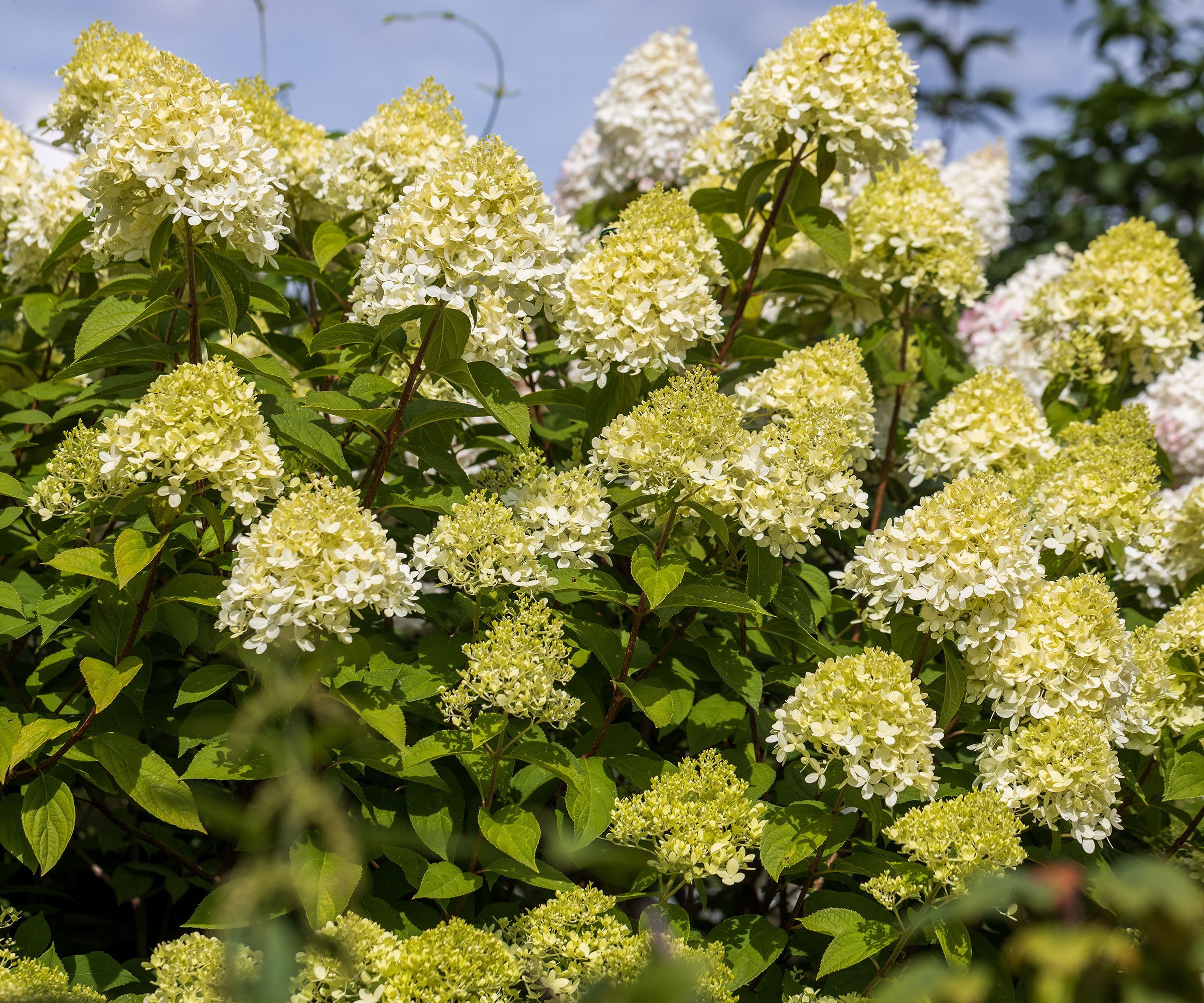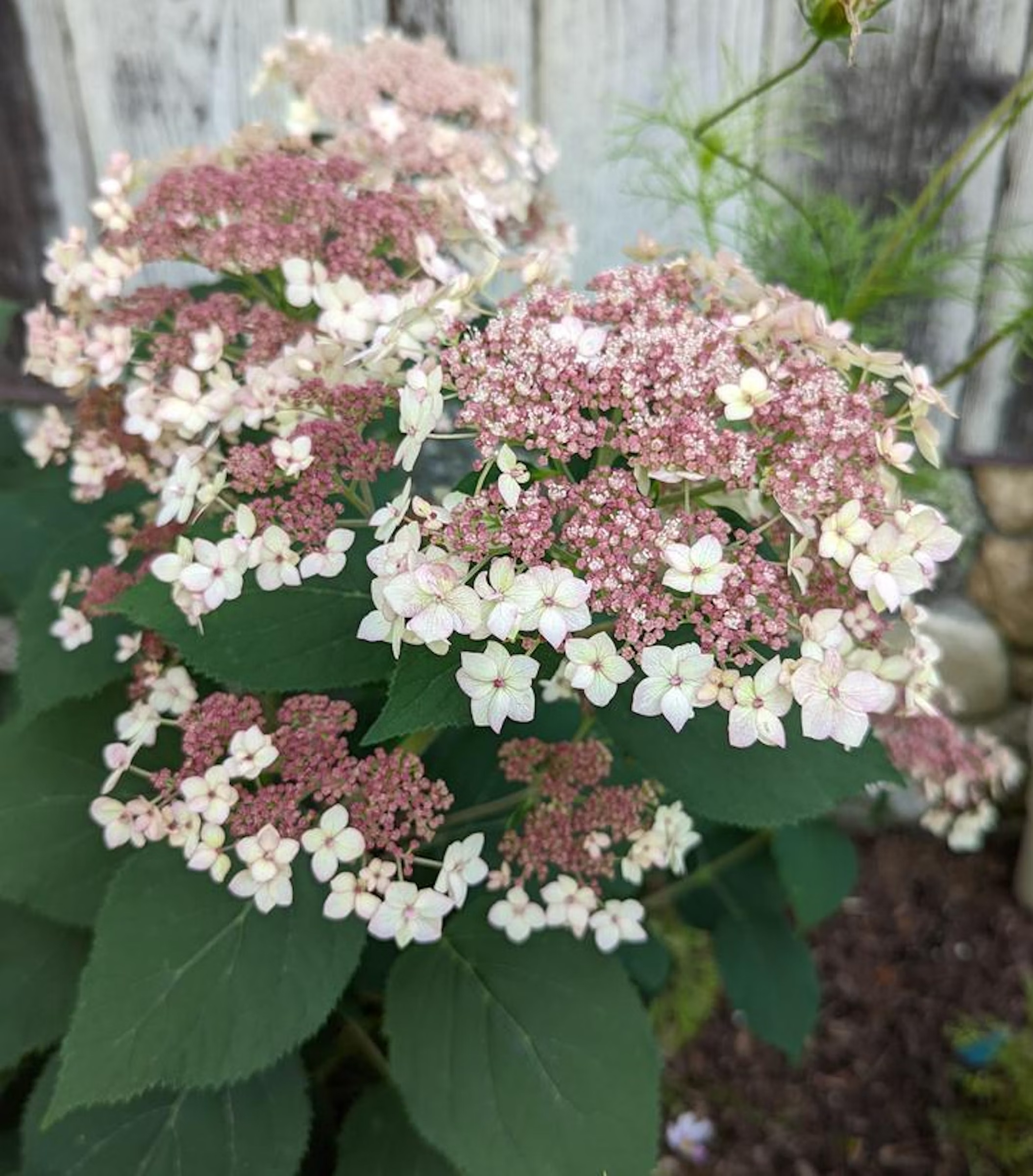10 Best Flowering Bushes For Big, Showy Blooms
Looking for a flowering shrub to add to your landscape? Check out our list of ten of the most beautiful blooming bushes.


Liz Baessler
Shrubs are sometimes called the bones of the garden, but that doesn’t mean that they must be strictly utilitarian. Flowering bushes serve just as well as foliage plants to provide structure to your landscape, and – with adequate planning – you can select bushes with flowers in all four seasons.
So, what blooming shrubs should you consider if your goal is year-round color? We’ve got suggestions for you for flowering shrubs for every season.
The 10 Best Flowering Shrubs
Spring, summer, winter and fall - flowering bushes liven up your garden, adding vivid color and sometimes fragrance. Flowers also provide nectar for insects, while their fruits provide food for wild birds and mammals.
Every garden needs flowering shrubs. Here are our very favorites.
1. Panicle Hydrangea (Hydrangea paniculata)

Many shrubs that seem to have huge flowers actually have large clusters of small flowers instead. The popular panicle hydrangea is one of these, with pointed panicles of creamy blossoms. They are extremely showy from the moment they flower, but continue to delight throughout the season. As they mature, the white blooms turn pink, then bronze, and they can hang onto the branches long into the winter. They thrive in USDA zones 3-8.
2. Crepe myrtle (Lagerstroemia indica)

Crepe myrtle is known as the flowering shrub of the American South, with enormous, papery clusters of bright red and rose flowers some 6-10 inches (15-25 cm) long. Modern cultivars are hardy down to USDA hardiness zone 6 and offer additional flower shades including white, lavender and purple. It is possible to find cultivars with fragrant blooms.
3. Smooth Hydrangea (Hydrangea arborescens)

All hydrangea are garden workhorses, but growing smooth hydrangea is considered by many to the most reliable and rewarding. Extremely popular shrubs, smooth hydrangea thrive in a wide range of hardiness zones, from USDA zone 3 – 9. They are more compact than other hydrangea species, rarely getting taller than the gardener but often wider than they are tall.
Sign up for the Gardening Know How newsletter today and receive a free copy of our e-book "How to Grow Delicious Tomatoes".
They offer an abundance of large, showy flowers from spring through fall. The blossoms are held above the branches, looking for all the world like bouquets in vases. They grow in green, but quickly mature to a snowy white. If you really want a long growing season, skip the traditional smooth hydrangea types and opt for the Endless Summer varieties. These bloom on both old wood (last year’s branches) and new wood (grown during the present season), which extends the bloom time for up to 12 weeks.
4. Winter Heath (Erica Carnea)

This short winter bloomer is a native of Europe and prefers mild climates like USDA hardiness zones 7-9. It is an evergreen shrub that is also low-maintenance and drought tolerant, perfect for a textural ground cover. Its appeal lasts all year long.
Winter heath grows to about 1 foot (0.3m) tall, forming buds in the summer, but blooming in winter – offering flowers as early as November in some cultivars, closer to January in others. The drooping flowers are shaped like urns, in shades of red, purple, pink and white. Once flowering, winter heath can keep blooming for months. That means that a cultivar that flowers in December can still be providing color in the garden in April or May.
The small, drooping, urn-shaped flowers of winter heath typically come in shades of red, pink, purple, and white. As the clusters of tiny blooms mature, their color sometimes deepens.
5. Glossy Abelia (Abelia × grandiflora)

Gardeners in USDA zones 6 – 9 should really consider growing glossy abelia. This hybrid of two Chinese species has been around for some years but deserves to be far more popular. The beauty, variety, and longevity of the floral display offered by glossy abelia is astonishing.
The showy white blossoms bloom on new wood. They appear in June and last through the first frost. To add to the beauty, the sepals below the petals blush pink in the early fall. The ornamental value is heightened by the lush green foliage that decorates the shrub all year long in USDA zones 7 and above. You can even use glossy abelia in a flowering hedge – it tolerates pruning and shearing.
6. Shrubby Cinquefoil (Potentilla fruticosa)

Here’s another of our favorites on the list of flowering bushes. Shrubby cinquefoil (also known as shrubby potentilla) is a tough shrub that will light up your landscape with bright, five-petaled flowers in vivid colors from yellow to orange to red. All of this beauty comes in a very practical package since the bush will thrive in most conditions in USDA zones 3 – 7.
Shrubby cinquefoil grows to 4 feet (1.3m) tall and to 5 feet (1.6m) wide. It is a deciduous shrub that blooms from June through September.
7. Dawn Viburnum (Viburnum x bodnantense)

Although we all love blossoms that appear in the colder months, many gardeners don’t think about planting winter-flowering shrubs – and this is a big mistake in mild climate. Nothing takes the sting out of overcast winter weather like flowers opening in the garden.
Consider Dawn viburnum, a medium-size deciduous shrub (to 10 feet/3.3m) that drops its foliage in autumn. But the show is just beginning! After the leaf-drop, this viburnum produces utterly lovely blossoms on bare branches, clusters of small, pink, fragrant flowers that decorate the garden through winter. You can cut off branches and take them inside for forcing. Or walk through the winter garden, intoxicated by the power of the extraordinary scent. Dawn viburnum is hardy to USDA zone 4.
8. Mophead Hydrangea (Hydrangeas macrophylla)

Mophead hydrangeas have more than foliage that is oversized. These flowering shrubs are also called snowball hydrangeas. They are known for their round flower clusters (actually sterile bracts) that are larger than a grapefruit and sometimes the size of a cantaloupe. These are the flowering shrubs that bloom in red or blue depending on the acidity of the soil and can flower for months on end. Easy to grow, they do well in lowlight areas and require a location that gets good shade in the afternoon. They thrive in USDA zones 6-9.
9. Azalea (Rhododendron spp.)

Azaleas are shade-loving flowering shrubs, some evergreen, others deciduous that grow to 10 feet (3 m) in both directions. An azalea will produce vast amounts of funnel-shaped blooms, lighting up the garden in spring with white, purple, yellow, or red flowers. While they can take some sun, in zones 6-8 they do best in a shady area that only gets a bit of morning sun.
10. Hardy Begonia (Begonia grandis)

Hardy begonia cultivars thrive in USDA zones 6 to 9. These are shade-loving flowering shrubs with green wing-shaped leaves that are red beneath. The plants also have flower clusters dangling on the end of pinkish-red stems. Cold-hardy begonias grow up to 2 feet (60 cm) tall and wide. They include Begonia grandis ‘Alba’ with white blossoms and Begonia grandis ‘Torsa’ with large, broad leaves and clusters of pink flowers.
Frequently Asked Questions
Is there a shrub that blooms all summer?
More than a few shrubs can bloom all summer in ideal growing conditions. These include smooth hydrangea.
What shrubs flower the longest?
The duration of bloom depends partly on the shrub species, but also on the climate, soil, irrigation, and other cultural conditions. Shrubby cinquefoil is one bush that blooms for many months during the growing season if its cultural requirements are met.
This article features products available from third-party vendors on the Gardening Know How Shop.

Teo Spengler is a master gardener and a docent at the San Francisco Botanical Garden, where she hosts public tours. She has studied horticulture and written about nature, trees, plants, and gardening for more than two decades, following a career as an attorney and legal writer. Her extended family includes some 30 houseplants and hundreds of outdoor plants, including 250 trees, which are her main passion. Spengler currently splits her life between San Francisco and the French Basque Country, though she was raised in Alaska, giving her experience of gardening in a range of climates.
- Liz BaesslerSenior Editor

